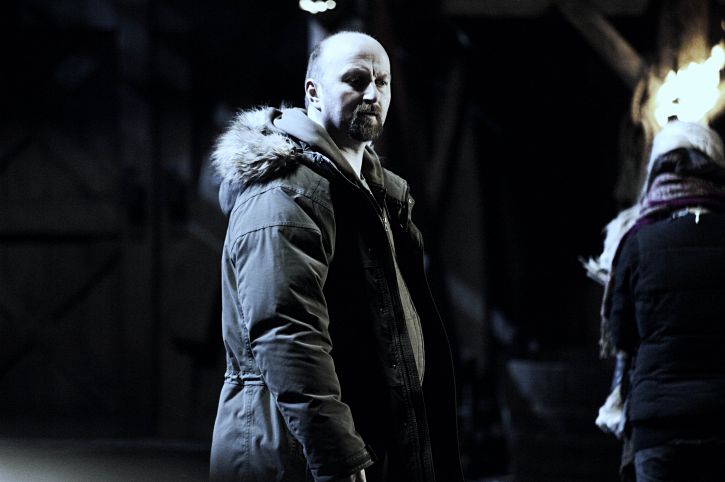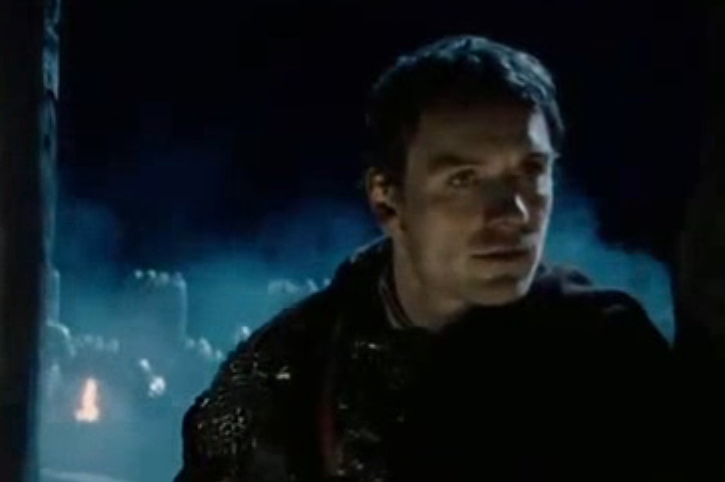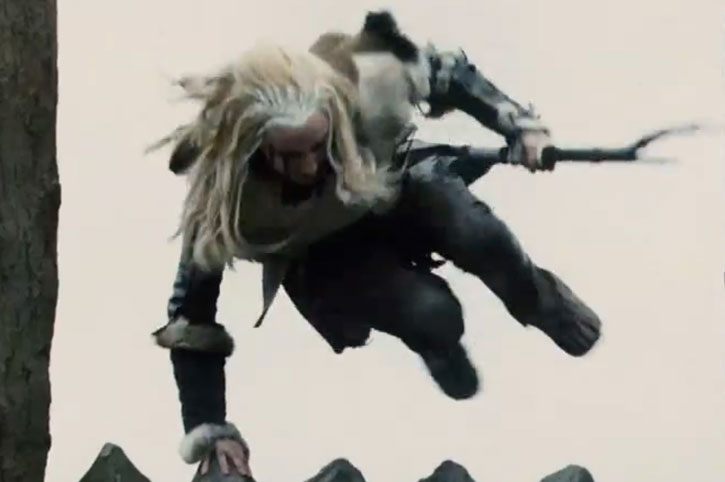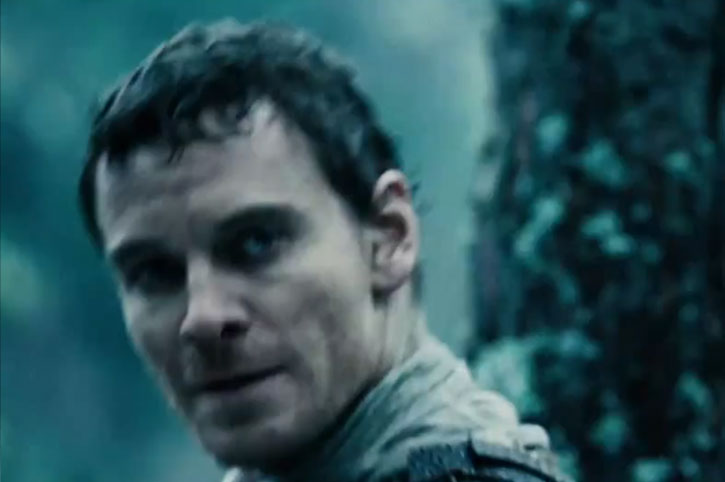
|

|

|

|

|

|

|

|

|

|

|

|



Exclusive: Neil Marshall on His Bloody 'Centurion'
Few genre directors these days maintain a batting average as consistently high as Neil Marshall (if the Scottish filmmaker will permit a US-rooted analogy). Through all four of his films – Dog Soldiers, The Descent, Doomsday, and Centurion – Marshall has consistently delivered smart, fast-paced, thrilling entertainment, blending genres in a way that draws comparisons to the best of Carpenter or Tarantino. I sat down last week with Marshall and his wife and partner Axelle Carolyn to chat about Centurion (in which Carolyn co-stars) and about the way in which this new mini-epic -- about the last honest Roman warrior on the northern frontier -- explores some of the themes in the director's other work (while offering some first-rate kills for the discerning gore fan). Hit the jump for our conversation.
Q: Like your previous three films, Centurion restores one's faith that contemporary genre films can be made that are neither super low-budget nor the product of Hollywood studios.
Marshall: I've been very lucky to get these low to medium budget films within specific genres and cross-genre mixes made.
Q: And as in your other films, there's a particular group dynamic in Centurion. If I could title a book on your films, I'd go with "Band on the Run".
Marshall: [Laughs] Yeah I'll have to try something different next time. I don't want to be seen as just doing "band on the run." I do love it though. I love the gang on the run [from] a certain situation. I liked flipping it on its head with Descent, the fact that they kind of dissipated and turned on each other. That was the whole point of that one. But with this one, it's going back to more of the Dog Soldiers thing, where there's a bunch of soldiers, unity, and sense of brotherhood between them. I love doing that sort of thing. It's hugely inspired by some of Howard Hawks' movies.

Q: It would seem difficult to do, however, because so few filmmakers these days successfully do this sort of thing. Hawks did it back in the day, and Carpenter and Cameron did it in the ‘80s. How challenging is it to do?
Marshall: The main challenge is putting the right cast together. Once you have the right cast, you have the diversity of interest in the characters anyway. A richness comes from them and that helps enormously. What I also tend to do is have the dialogue that's in the script as a starting point, and with the actors we work with it and see what else we can come up with. There was a lot of improv with Dog Soldiers as well, as far as the group banter was concerned. There's less so with this one, but it's always fun to do that.
Q: Axelle, as an actor in this ensemble, can you comment on the balance you see Neil strike between developing a character just enough to give them a strong identity, yet not to the point that it slows down the action and story movement?
Carolyn: In my case the character in the script was not extremely developed. It was kind of mentioned that she was in several scenes. I don't even think it was mentioned that she was a woman. It was just a warrior doing several things throughout the script and my take on it was to try to see the way the other ones were described and the kind of characters they were playing. The most obvious for me as a woman was Olga Kurylenko's character since she was the other warrior woman, and the way she approached it was to try to make her sympathetic and try to make her someone who has this whole back story that explains why she is violent and why she's doing the things she is now. So I thought it would be interesting if my character was the opposite and was just mean. Someone who enjoys fighting. There's always got to be someone in a group of anything who's just there because they get a kick out of it. That's what I chose to play and it's not something that takes a lot of space. My role doesn't have a lot of dialogue, so it was just finding those opportunities to make it look like I was enjoying what I was doing. I think that brought a little variety to the ensemble of the Picts and made her look a little more threatening.
Marshall: It's kind of a challenge to see how much character you can get from someone without necessarily having huge dialogue scenes. It's character through action. It speaks louder than words anyway.
Carolyn: That was the case for Olga too. She's mute in the film so she had to give the character personality through what she was doing and through looks and behavior, and I thought she did that really well. It was important to have some kind of bounds between characters, because the Picts don't have huge scenes of conversation between them. You need to have a sense of who they are and a sense of individuality just through what they are doing. That was the main thing.
Marshall: It was great having the opportunity on set to come up with ideas that would very much show the personality of these individuals.

Q: It's interesting that Olga's character is described as feral throughout the film, but in a way yours is more so because you're playing an attack machine.
Carolyn: I'm just embracing it.
Marshall: It's like your character's having a death wish. You definitely get your wish [Laughs]
Carolyn: The way I saw it is, I'm a girl, I'm blonde, I don't look extremely strong, I don't look extremely threatening naturally, so I thought the only way I can make my character striking or impressive as in you can see why those guys would run away from that little girl is if she's insane. If she doesn't have a weapon she's going to bite you. Originally I wanted to have my teeth filed to make it look like I was completely insane, but they didn't go for that.
Marshall: Just that level of insanity and cruelty as well. I've said a few times now that it would be a great drinking game with the movie. You have to down a shot of Scotch (it has to be Scotch) [laughs] every time Axelle shoots someone in the back. She shoots three guys in the first ten minutes, so you're well on your way by then.
Carolyn: I think it's something like eight or nine throughout the film.
Marshall: We weren't even necessarily conscious of it when we were making it, but when we put it together, the edit looks like she's constantly shooting people in the back [Laughs].
Q: We'll try to see that college dorms across the country pick up that challenge. [Laughs] In terms of genres and the way that you like to mix and match them, can you talk about some of the things that you saw yourself doing in this film?
Marshall: Well there are a few things. First of all it's always going to get referred to as a sword-and-sandals movie. But to me that's all about deserts and dust and Jerusalem, and those are the kinds of things I associate with Roman movies, be it Gladiator or Life of Brian or whatever. I wanted to do the flip side of that, because this is about the frontier. This is their father's frontier and Scotland is not like that. It's muddy and rainy and cold. I'd never seen a sword-and-sandals movie like that, aside from the opening ten minutes of Gladiator. That's the only roman movie I can think of that takes place in the rain and the snow. So I definitely wanted to play around with that. Mainly I see this as a Roman western. The frontier was the equivalent of the Wild West to the Romans so it was the edge of the world to them. It was like being on the moon. That western thing stuck in my head and I compared it mainly to the old John Ford cavalry movies like Rio Grande, She Wore a Yellow Ribbon, and Fort Apache. That's what this movie is. The Romans are the cavalry and the Picts are the Comanches, and as such it throws it into that weird grey area where those films now would be incredibly encompassing. If you could make those now, telling the story from the invaders' point of view and getting you to root for the invaders… I actually thought it was an interesting challenge. I didn't want to make this a pro-Roman film or pro-empire film, but it is about individuals who are forced by circumstance to fight for their lives within that situation. So it's all about the individuals. The best villains in movies are ones that you totally get their motivation, and from their point of view they're doing what they do because they totally believe it. If you identify with their motivation, then it makes it all the more scary.

Carolyn: They're just defending their land and that's something everyone can understand. They're defending their families and that's why the film never shows, with the exception of my character, us being savages or horrible people.
Marshall: As a whole the Picts are the antagonists, they're not the villains. There are villains within that group, and I wanted to totally justify her behavior. She's being raped and having her tongue cut out by the Romans so she wants to kill the Romans. You can't help but sympathize with that. At the same time you don't want her coming after you. [Laughs] So I wanted to play around with those grey areas and make it interesting that way.
Carolyn: Someone made a great point about that. It's kind of like the war in Iraq or Afghanistan. It doesn't matter what you think of the war. It doesn't matter if you think Americans should be there or not. You do want Americans to come back and you want soldiers to come back and be safe with their families. This is kind of the same thing. It doesn't ask you to believe that the Romans should be invading anything. It just says those guys are human beings. We want them to be safe and come back. We want you to sympathize with that journey of them coming back.
Marshall: Right. The cause long since went out the window.
